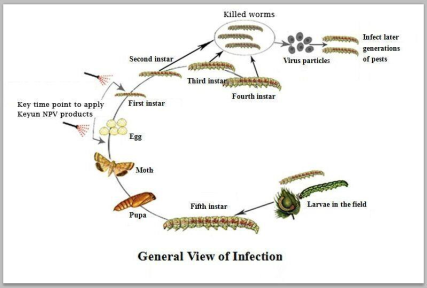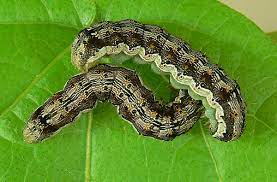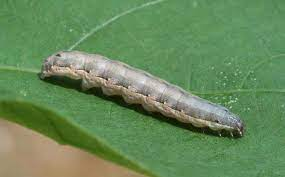Ecoman NPV product
Ecoman NPV product
Nuclear Polyhedrosis Virus (NPV) is a naturally existing microorganism which does no harm to humans and animals but only kills the targeted pests. When NPVs are applied on crops, it is ingested by the pests. The virions are released which replicate massively and spread all over the body and consume body tissues rapidly. Pests don’t eat and move during their illness, which shows the sublethal effect. In the end they die with their internal organs and tissues liquefied. Furthermore, the virions spread like plague among and throughout several generations of the targeted pests by fluid or feces from the dead pests, thus effectively controlling field pests in a long term.

Product features:
- Highly specific
- No development of resistance
- No harm to natural enemies
- No residues
- Can be applied up to and including the day of harvest and storage.
1. Helicoverpa armigera Nuclear polyhedrosis virus (HaNPV)
Crops: Cotton, vegetables etc.
Target pest: Helicoverpa spp. (Cotton Bollworm)

Helicoverpa armigera pheromone lure is recommended to monitor the pest occurrence. The monitoring results help in determining the right time of application, hence improving the control efficacy.
Trial crop: Cotton
Trial Treatment:
|
Treatment |
Product |
Dosage/mu (Dosage/0.16 acre) |
|
T1 |
5 Billion PIB/ml Helicoverpa armigera NPV |
20ml |
|
T2 |
30% fenturamide·phoxim emulsifiable concentrate
|
60ml |
|
T3 |
5 Billion PIB/ml Helicoverpa armigera NPV + 30% fenturamide·phoxim emulsifiable concentrate
|
20ml+60ml |
|
CK |
Blank control |
|
Area and repetition:
50 mu (Approx. 8 acres) for treatment 1, 2 and 3 (T1, T2 & T3), 1 mu (0.16 acre) for blank control (CK).
Application method:
The insect population was monitored with the pheromone lure, and foliar spraying was carried out for control during the low-instar larval stage of cotton bollworm, with a water consumption of 15L per mu (0.16 acre). The solution was prepared according to the dosage in Table 1, the method of secondary dilution was adopted. First, a small amount of water was added to prepare the original solution, then enough water was added to prepare the required concentration solution for spraying, and it was evenly sprayed on the cotton. The pesticide was applied on August 13, 2020. To avoid exposure to direct sunlight, as it affects the efficacy of the drug, the spraying application was conducted after sunset. No other pests, diseases or weeds were controlled during the demonstration period.
Results of trial using 5 Billion PIB/ml Helicoverpa armigera NPV for Cotton bollworm control on cotton.
|
Treatment |
3 days after application |
5 days after application |
7 days after application |
10 days after application |
||||
|
Reduction rate (%) |
Control effect(%) |
Reduction rate (%) |
Control effect(%) |
Reduction rate (%) |
Control effect(%) |
Reduction rate (%) |
Control effect(%) |
|
|
1 |
20.33 |
22.52b |
79.33 |
80.19a |
83.42 |
82.62ab |
87.64 |
86.60a |
|
2 |
73.29 |
74.03a |
67.36 |
68.72b |
71.53 |
70.15b |
65.33 |
62.43b |
|
3 |
74.73 |
75.43a |
76.33 |
77.32a |
83.67 |
82.88a |
85.43 |
84.21a |
|
CK |
-2.83 |
/ |
-4.35 |
/ |
4.63 |
/ |
7.73 |
/ |
As observed from Table 2, 3 days, 5 days, 7 days, and 10 days after application, the control effects of Helicoverpa armigera NPV alone were 22.52%, 80.19%, 82.62%, and 86.60% respectively; The control effects of the control agent were 74.03%, 68.72%, 70.15%, and 62.43% respectively.
Field trial demonstration results showed that 5 billion PIB/ml Helicoverpa armigera NPV suspension effectively controlled the cotton bollworm on cotton. Its early control effect was lower than the control agent 5% fenturon and phoxim suspension. The control effect after 5 days is equivalent to that of chemical agents. 5 billion PIB/ml Helicoverpa armigera NPV suspension had a slower but long-lasting effect. It was safe and harmless to crops and developed no resistance. During the trial demonstration, a large number of Helicoverpa armigera were clearly observed, which proved that 5 billion PIB/ml Helicoverpa armigera NPV is suitable for large-scale control of cotton bollworm.
2. Spodoptera exigua Nuclear polyhedrosis virus (SeNPV)
Crops: Cruciferous vegetables
Target pest: Spodoptera exigua (Beet Armyworm)

Spodoptera exigua pheromone lure is recommended to monitor the pest occurrence. The
monitoring results help in determining the right time of application, hence improving the
control efficacy.
Trial Crop: Soybean
Trial Treatment:
|
Treatment |
Product |
Dosage/mu (Dosage/0.16 acre) |
|
T1 |
3 Billion PIB/ml Spodoptera exigua NPV suspension |
30ml |
|
T2 |
8% emamectin·lufenuron suspension |
30ml |
|
T3 |
3 Billion PIB/ml Spodoptera exigua NPV suspension + 8% emamectin·lufenuron suspension |
30ml+30ml |
|
CK |
Blank control |
|
Area and Repetition:
50 mu (Approx. 8 acres) for treatment 1, 2 and 3 (T1, T2 & T3), 1 mu (0.16 acre) for blank control (CK).
Application method:
The insect population was monitored with S. exigua pheromone lure, and foliar spraying was carried out for control during the low-instar larval stage of beet armyworm, with a water consumption of 15L per mu (0.16 acre). The solution was prepared according to the dosage in Table 1, the method of secondary dilution was adopted. First, a small amount of water was added to prepare the original solution, then enough water was added to prepare the required concentration solution for spraying, and it was evenly sprayed on the soybean. The pesticide was applied on July 23, 2023. To avoid exposure to direct sunlight, as it affects the efficacy of the drug, the spraying application was conducted after sunset. No other pests, diseases or weeds were controlled during the demonstration period.
Results of trial using 3 Billion PIB/ml Spodoptera exigua NPV for beet armyworm control on soybean.
As observed from Table 2, 3 days, 5 days, 7 days, and 10 days after application, the control effects of Spodoptera exigua NPV alone were 19.53%, 77.21%, 76.53%, and 81.73% respectively; The control effects of the control agent were 71.76%, 66.73%, 63.83%, and 60.39% respectively.
Field trial demonstration results showed that 3 billion PIB/ml Spodoptera frugiperda NPV suspension can effectively control Spodoptera exigua on soybean. Its early control effect was lower than the control agent 8% emamectin·lufenuron suspension. The control effect after 5 days is equivalent to that of chemical agents. 3 billion PIB/ml Spodoptera exigua NPV suspension had a slower but longer lasting effect. It was safe and harmless to crops and developed no resistance. During the trial demonstration, a large number of Spodoptera exigua were clearly observed, which proved that 3 billion PIB/ml Spodoptera exigua NPV is suitable for large-scale control of beet armyworm.



